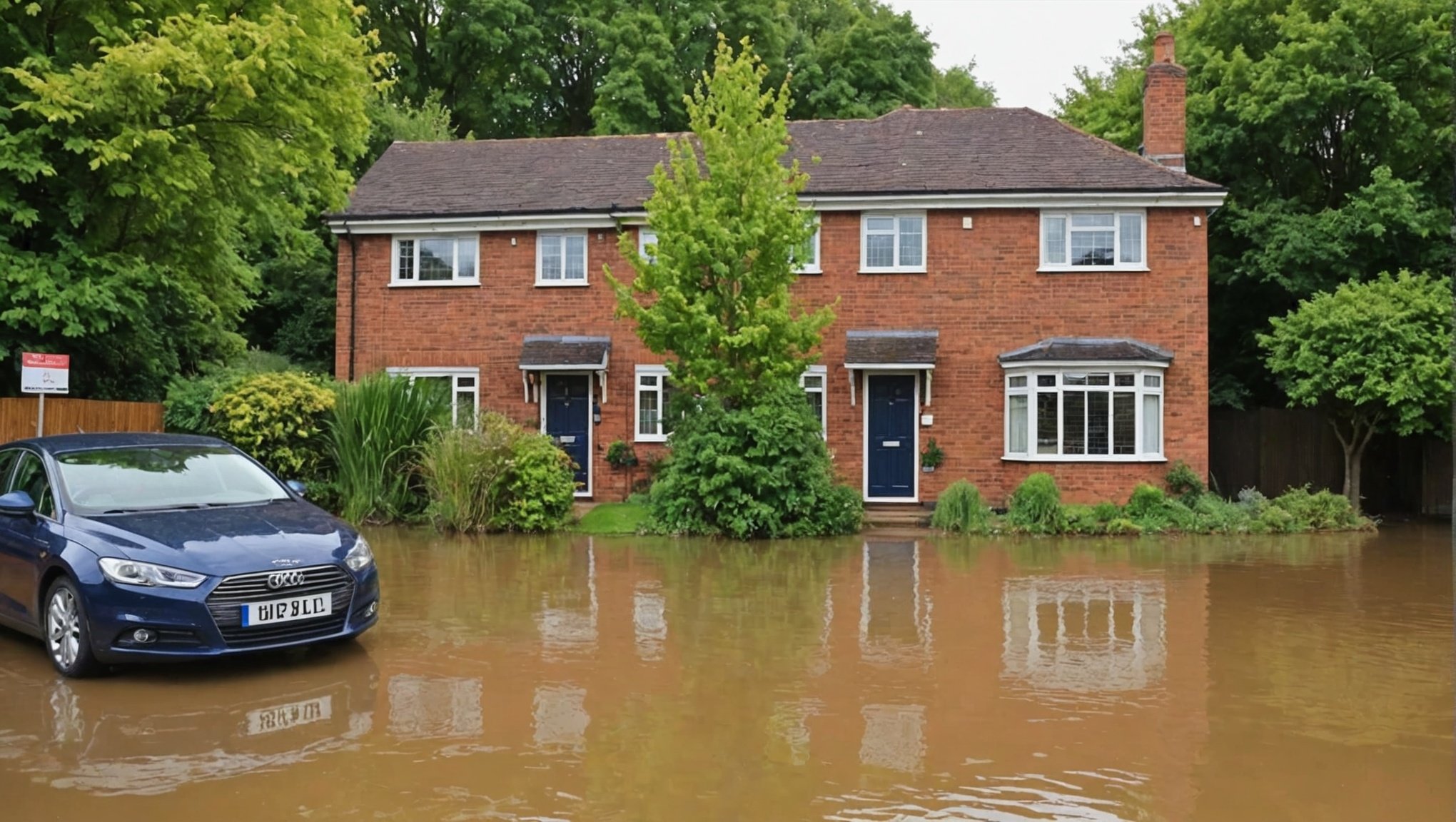When considering a property purchase in the UK, the potential risk of flooding is an important factor that should not be overlooked. Forecasting the possibility of your dream house being at the mercy of flood water can potentially save you considerable hardship and financial strain. The process of evaluating the risk involves a thorough understanding of the property’s area, local flood schemes, insurance considerations, and conducting a detailed flood risk report. By the end of this guide, you’ll have a blueprint for making informed property purchase decisions that factor in the risk of flooding.
Understanding the Area’s Flooding History
Before considering a property, it’s crucial to understand the history of flooding in the area. This assessment involves studying the local topography, drainage networks, and past flood events.
Avez-vous vu cela : Unlocking the secrets to effective credit management
The UK Environment Agency’s website offers a wealth of information. Their flood map service provides details on high-risk zones, areas that have previously been affected by flooding, and locations protected by flood defences. This knowledge will aid in making an informed decision when purchasing a property.
Local councils also provide a wealth of information, including the likelihood of flooding in specific areas and potential future flood schemes. It’s worth noting that the development of new flood defences could significantly reduce the flood risk for properties in certain areas.
A voir aussi : How can non-residents secure a mortgage for UK property investment?
Evaluating Local Flood Schemes
Local flood schemes play a massive role in an area’s susceptibility to flooding. When you’re thinking of buying property, it’s essential to know if the area benefits from flood defences and what they entail.
A flood scheme can range from simple, small-scale interventions like elevated doorways and waterproof walls to more complex, large-scale projects such as flood barriers and new drainage systems. These schemes are typically funded and maintained by the local council, the Environment Agency, or private developers.
The efficacy of these flood schemes will also affect your property’s insurance. When an area is equipped with robust, well-maintained flood defences, it is less likely for properties within it to be severely affected by flooding, which can make insurance coverage more affordable.
The Role of Flood Risk Insurance
When purchasing a property in an area with a high risk of flooding, the availability and cost of insurance will be a crucial consideration. In the UK, the Flood Re scheme allows homeowners in high-risk areas to secure affordable flood insurance.
Under the Flood Re scheme, insurers pass the flood risk element of home insurance policies to Flood Re, which charges a fixed premium based on the property’s council tax band. The scheme can significantly reduce the cost of flood insurance for homeowners. However, some properties aren’t eligible for Flood Re, such as those built after January 2009. It’s therefore paramount to check the property’s eligibility before committing to the purchase.
Conducting a Detailed Flood Risk Report
A detailed flood risk report provides an in-depth analysis of the property’s vulnerability to flooding. It gives you a comprehensive understanding of the flood risk, which is invaluable when deciding whether to proceed with the purchase.
The report will examine the property’s location, local topography, historical flood records, proximity to water sources, and local flood defences. It will also include a risk assessment based on the potential sources of flooding, such as rainfall, rivers, tides, and groundwater, and take into account the possible impact of climate change on future flood risk.
A flood risk report can pinpoint the specific parts of the property that are most at risk and suggest appropriate mitigation measures. If the report indicates a high risk of flooding, it might be worthwhile to reconsider the purchase or negotiate a lower price to accommodate the cost of potential flood-proofing works.
Before Buying a Flooded Property
A house that has previously been flooded may come with its own set of challenges. From increased insurance costs to ongoing maintenance requirements, the obstacles can be significant. However, if the property ticks all your other boxes, it would be wise to take a few additional steps before making a purchase.
Firstly, find out the severity and frequency of the flooding incidents. This information will provide a clearer picture of what you might be signing up for. Secondly, get a detailed survey of the property to understand the extent of any damage caused by previous floods, including potential issues like damp, rot, or structural instability.
Finally, get an estimate for the cost of any necessary repair work and flood-proofing measures. This could be a significant expenditure, so factor it into your budget before deciding on the purchase. Remember, investing in a flooded property might require more than just monetary investment; an emotional one too. Be prepared for the potential challenges and the aftermath of flood events.
By taking the time to assess the flood risk before purchasing a UK property, you can secure not just a house, but a safe and secure home for the future.
Considerations for Surface Water Flooding
Deciphering the risk of surface water flooding is an essential part of assessing a property’s flood risk. Surface water flooding refers to instances when rainwater does not drain away through the normal drainage systems or soak into the ground, but lies on or flows over the surface instead. This type of flooding could be due to heavy rainfall, poor drainage systems, or changes in the surrounding landscape.
The Environment Agency provides a surface water flood map that can help you understand the risk in any given area. This resource identifies areas that are at risk of flooding from surface water, based on the most severe weather that can realistically occur. It’s important to bear in mind that this does not include the impact of any flood defences, as these can fail in extreme weather conditions.
In addition to this, it’s crucial to understand the drainage situation of the property you’re considering. Poor drainage systems can make a property very susceptible to surface water flooding. Therefore, enquire about the state of the drainage systems in and around the property. A local surveyor or the property’s current owners may be able to provide this information.
Lastly, take note of any significant changes in the landscape surrounding the property. Construction, deforestation, or changes in land usage can all affect how water flows in the area and increase the risk of surface water flooding. Be vigilant about any such changes, as they could heighten the flood risk for the property.
The Impact of Historic Flooding on Property Purchase
Historic flooding data plays a significant role when assessing a property’s flood risk. Understanding the flooding history of an area provides valuable insights into the likelihood of future flooding incidents.
The Environment Agency keeps records of past flood events, which can provide a sense of how frequently and severely the area has flooded in the past. These records can be accessed online and will give you an idea of the flood patterns in the area.
Moreover, look into any changes made following historic floods. Have there been improvements to the drainage systems or the development of new flood defences? Such changes could alter the flood risk profile of a property.
For a property that has been flooded in the past, it’s crucial to understand the extent of the damage and the impact it had on the house. This will give you an idea of what you might expect if a flood were to occur in the future. You should also find out if any repairs or flood resilience measures were put in place after the flooding.
Historic flooding can also affect insurance premiums. Properties that have a history of flooding might be subject to higher insurance premiums due to the increased risk. Therefore, inquire about the impact of historic flooding on insurance costs to avoid any surprises.
Conclusion
In conclusion, assessing the flood risk before purchasing a UK property is a crucial step to ensure a safe and secure home for the future. As a potential homeowner, understanding the area’s flooding history, evaluating local flood schemes, considering surface water flooding and the impact of historic flooding can save you from future hardships.
Remember to review the Environment Agency’s resources, conduct a detailed flood risk report, and understand the role of flood insurance in protecting your property. If you’re considering a property that has been flooded before, be prepared for the potential challenges and the aftermath of flood events.
By diligently investigating these aspects, you can make an informed decision about your property purchase. Taking the time to do your homework will not only save you from potential financial strain but also provide you with peace of mind. After all, your home should be a place of safety and comfort, not a source of constant worry about the potential for flooding.











